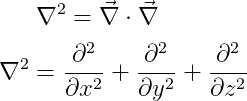The Laplacian or Laplace operator is a very important differential operator used in physics, engineering, and mathematics. It is denoted by the square of the nabla symbol, written as ∇².
In this guide, we will see different ways to write the Laplacian operator neatly and accurately.
Basic Representation
When you want to write only the Laplacian symbol, the simplest way is to use \nabla^{2}. It produces a perfect ∇² sign for mathematical display equations.
\documentclass{article}
\begin{document}
\[ \nabla^{2} \]
\end{document}Output :
Expanded Mathematical Form
In vector calculus, the Laplacian operator can be expressed as the dot product of two gradient operators.
It helps to understand its physical meaning in three-dimensional space. The operator expands as the sum of the second partial derivatives with respect to each spatial coordinate.
\documentclass{article}
\begin{document}
\[ \nabla^{2}=\vec{\nabla}\cdot\vec{\nabla} \]
\[ \nabla^{2}=\frac{\partial^2 }{\partial x^2}+\frac{\partial^2 }{\partial y^2}+\frac{\partial^2 }{\partial z^2} \]
\end{document}Output :
Using Physics Package
The physics package is one of the most convenient packages for mathematical writing.
It provides many pre-defined operators including \laplacian for the Laplace operator.
\documentclass{article}
\usepackage{physics}
\begin{document}
\[ \laplacian \]
\[ \laplacian{f} \]
\[ \laplacian(f_{1}+f_{2}) \]
\[ \laplacian[f_{1}+f_{2}+\cdots+f_{n}] \]
\end{document}Output :
Using Custom Commands for Reusability
If you are writing a long thesis or a paper with many equations, it’s better to define a custom command for the Laplacian operator. This makes your LaTeX code shorter and easier to maintain.
\newcommand{\Lap}{\nabla^{2}}
- \newcommand
- This command is used to define a new macro in LaTeX that can replace repetitive content.
- \Lap
- The custom name given to the Laplacian operator. You can use any name you prefer.
- \nabla^{2}
- This is the mathematical content that will be displayed each time you use
\Lap.
\documentclass{article}
\newcommand{\Lap}{\nabla^{2}}
\begin{document}
The Laplacian of $f$ is written as $\Lap f$.
\end{document}Different Coordinate Systems
The Laplacian operator takes different forms in various coordinate systems. You can represent these forms clearly in LaTeX using subscripts and fractions.
\[ \nabla^2 = \frac{\partial^2}{\partial x^2}+\frac{\partial^2}{\partial y^2}+\frac{\partial^2}{\partial z^2}\]
\[ \nabla^2 = \frac{1}{r}\frac{\partial}{\partial r}(r\frac{\partial}{\partial r})+\frac{1}{r^2}\frac{\partial^2}{\partial \theta^2}+\frac{\partial^2}{\partial z^2}\]
\[ \nabla^2 = \frac{1}{r^2}\frac{\partial}{\partial r}(r^2\frac{\partial}{\partial r})+\frac{1}{r^2\sin\theta}\frac{\partial}{\partial \theta}(\sin\theta\frac{\partial}{\partial \theta})+\frac{1}{r^2\sin^2\theta}\frac{\partial^2}{\partial \phi^2} \]
